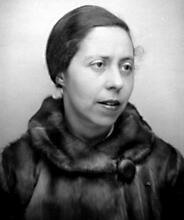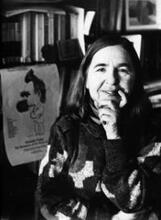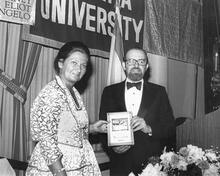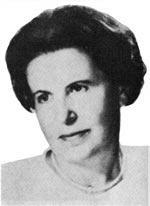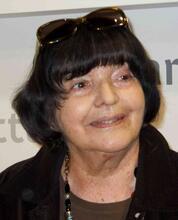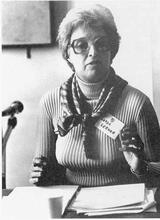Élisabeth Gille
Élisabeth Gille was a French author known most of all for biography of her mother, best-selling novelist Irène Némirovsky, murdered at Auschwitz. Borrowing Némirovsky’s own voice, Gille narrated the book in the first person as “dreamt memoirs.” Gille wrote two other books: an account of her battle with cancer and a fictionalized a novelization of her experiences as a Jewish child hidden during the German occupation and then adopted by non-Jewish resistance fighters. That work portrayed the incomplete understanding of the specificity of the Holocaust even among those sympathetic to its victims.
Élisabeth Gille was born Élisabeth Epstein in Paris on May 20, 1937, and died of cancer on September 30, 1996, just as she was achieving a certain amount of fame for three critically acclaimed books. She had worked since 1958 for such significant publishing houses as Denoël, Flammarion, and Julliard and was a respected translator from English. The authors she translated into French included Kate Millett, Peter Taylor, Alison Lurie, James Graham Ballard, and Mary Gordon.
Le Mirador: A Biography of Irène Némirovsky
Gille’s first measure of repute as a writer in her own right came with her publication of Le Mirador: Mémoires rêvés (1992; The Prison Tower: Dreamt Memoirs), a thorough biography of her mother, Irène Némirovsky (1903–1942). Némirovsky, who achieved significant success as a novelist in the 1930s, was deported from France to Auschwitz in July 1942; Gille’s father, Michel Epstein, was taken on the same route in November of that year. Neither returned.
Gille’s mother’s novels had been of largely antiquarian interest for decades. But 2004 saw the posthumous publication of her Suite française, which had remained until then in manuscript form. The book, which recounts the flight of the civilian population following the fall of France in 1940, became a bestseller in the original and in its English version. This renewed renown of Nemirovsky led in 2011 to the English translation of Gille’s biography as The Mirador: Dreamed Memories of Irène Némirovsky by Her Daughter. “Memories” is an inaccurate rendering of the word “mémoires” in the title. In its usage here, in the masculine gender, it can only mean “memoirs.” Following her more literary than historical bent, Gille used a fictional convention in her mother’s biography: she wrote it as remembrances recounted by Irène Némirovsky herself, in the first person. While that narrative strategy might surprise us, it had been used five years earlier by another Jewish writer in France. Pierre Pachet, (1937-2006) in his Autobiographie de mon père, spoke in his father’s voice to tell his father’s story, including his wartime experiences and his survival.
Élisabeth Gille, who had discovered her mother’s novels in the library of her lycée, was aided in her research for the book by her older sister, Denise Epstein, an archivist, who like Élisabeth was hidden with a Christian family during the war. We learn from Gille’s “autobiography” of her mother that Némirovsky was a scion of the Russified Jewish bourgeoisie of Kiev and Saint-Petersburg. Her family managed to flee to France at the time of the Bolshevik Revolution and kept their wealth, which enabled them to entertain in their Parisian salon impoverished émigré aristocrats who would surely have snubbed them back home. Given their brilliant connections, it is no surprise that the Némirovskys took pride in their distance from traditionalist or simply less assimilated Jews, or that their daughter Irène produced a literary oeuvre replete with Jewish figures that at best provoke ambivalence, and at worst deserve a place in Theodor Lessing’s or Sander L. Gilman’s symptomatologies of Jewish self-hatred.
Élisabeth Gille imagines her mother during the Nazi occupation, reproaching herself for her vitriolic portraits of Jews in her 1929 novel David Golder:
I am seized at times by a kind of vertigo, as I repent having written that book. I wonder if by excoriating the social milieu from which I had come and which I hated so, I have furnished antisemites with ammunition; I wonder whether I gave proof of a suicidal flightiness and thoughtlessness (Le Mirador 195).
To see how on-target Gille was as a writer, compare the words she attributed to her mother with an extract from an interview with Némirovsky that Gille perhaps never came across. There, her mother did, in fact, express compunction about her antisemitic portraiture, though in less severe terms than Gille imagines her doing (but this was only in 1935):
I am completely certain that if Hitler had already been in power, I would have greatly softened David Golder. … But I would have been wrong to do so; that would have been a weakness unworthy of a true writer (Quoted in Auscher 670).
Un paysage de cendres: Wartime Experiences
Gille re-elaborates some of her own wartime experiences in Un paysage de cendres, a novel printed the month she died. A translation was published as Shadows of a Childhood, but the title literally means “a landscape of ashes,” a clear allusion to the fate of those, including Gille’s parents, whose bodies were burned en masse in the death camps. Un paysage de cendres recounts the story of the child Léa Lévy, double-initialed as was the author’s born name Élisabeth Epstein. Léa is hidden in a Catholic convent. Like philosopher Sarah Kofman’s autobiography Rue Ordener, rue Labat, which appeared two years earlier, Gille’s novel includes excellent analysis of the complicated motives, combining basic human charity and ambivalence toward Jews, that doubtless dictated the actions of many rescuers of Jewish children in France and elsewhere. Here Gille renders the post-war musings of one of the nuns who saved the orphaned Léa Lévy, at great risk to their personal safety:
Sister Saint-Gabriel hardly knew what do with her. She was a heavy responsibility, but the idea of sending her to an orphanage, as they had suggested in Paris, was repellent. In the course of the years, she had become attached to the girl. Besides, to leave her might mean letting her fall back into the hands of the Jews, who, it was said, were combing all the countries that had been occupied for orphans to help people emigrate to Palestine. Obviously, she had nothing against the Jews, who had amply paid for their crime against Christ. But Léa’s parents had had her baptized. Even if they had converted in the hope of saving their lives and hers, she now belonged to the Catholic church. Her soul was saved, that was the essential thing. You don’t look a gift horse in the mouth. (Un paysage des cendres 118–119, my trans.)
The novel recounts the friendship between Léa and Bénédicte, a girl hidden at the convent for another reason: her parents are deeply involved in the Resistance. The two girls become almost pathologically inseparable. In what is a statistically probable reflection of the differing fates between so-called “racial” and political targets of the Nazis (a situation studied by historian Annette Wieviorka), Bénédicte’s parents survive the war, unlike Léa’s. They wish to adopt the young orphan, but in typical insensitivity to the fate of Jews, the French officials refuse to deliver a death certificate in the absence of material proof of her parents’ demise, until ten years have passed.
Gille—in what is surely a projection of her adult feelings (but fiction allows such things)—places in the mouth of the unbelievably precocious eleven-year-old Léa a clear awareness of the often inchoate distress some Jews in postwar France felt:
Now everybody has forgotten. No one wants to talk about it anymore. It’s 1948, the war has been over for only three years, and even the Jews are thinking only of the creation of the State of Israel. They don’t care about those who disappeared. The French even less so. (Un paysage de cendres 146, my trans.)
Her companion summons her to recall those “who gave their lives for the Resistance; my parents risked theirs.” “Not for the Jews. … Oh, no, not for the Jews,” responds Léa, “with rage.”
Le Crabe sur la banquette: Dealing with the Trauma of Cancer
Between her two books with a central Jewish thematic, Gille wrote one that dealt with another trauma, her battle with the disease that would kill her. The title, Le Crabe sur la banquette arrière (The Crab on the Back Seat), plays on the zodiacal association between cancer and the crab. The sole parallel that merits drawing between that work and the rest of Gille’s oeuvre is the no-man’s land inhabited both by the long-term cancer patient and the Jewish survivor still afflicted by the trauma of World War II, from which the rest of society has apparently recovered. Like the Jew who had either survived the camps or escaped deportation to them, the cancer sufferer feels that in the eyes of others “she should be either cured or dead.”
Le Crabe sur la banquette arrière, which had been written in dialogue form, was made into a TV film that aired on channel France 2 on December 1, 1996, to generally positive reviews. On May 26, 1997, Un paysage de cendres was awarded the Grand Literary Prize by the association of readers of Elle magazine. That novel had also been in the running for the coveted Goncourt Prize, but it was withdrawn from the competition after the author’s death—a decision that was decried in ironic terms by French television host Laure Adler. As recounted by Agathe Logeart in Le Monde, Adler suggested that as far as the Goncourt jury was concerned Gille apparently “should have had the good taste to wait a bit before dying.”
SELECTED WORKS BY ÉLISABETH GILLE
Le Mirador: Mémoires rêvés. Paris: France loisirs, 1992 (translated into English as The Mirador: Dreamed Memories of Irène Némirovsky by Her Daughter. Trans. Marina Harss. New York: New York Review Books, 2011).
Le Crabe sur la banquette arrière. Paris: Mercure de France, 1994.
Un paysage de cendres. Paris: Editions du Seuil, 1996 (translated into English as Shadows of a Childhood. Trans. Linda Coverdale. New York: New Press, 1998).
Auscher, Janine. “Nos interviews: Irène Némirovski [sic].” L’Univers Israélite 90.44 (July 5, 1935): 669–670.
Gilman, Sander L. Jewish Self-Hatred: Anti-Semitism and the Hidden Language of the Jews. Baltimore: Johns Hopkins University Press, 1986.
Kofman, Sarah. Rue Ordener, rue Labat. Paris: Galilée, 1994 (Rue Ordener, Rue Labat. Trans. Ann Smock. Lincoln, NE: University of Nebraska Press, 1996).
Lessing, Theodor. Der jüdische Selbsthass. Berlin: Jüdischer Verlag, 1930, second edition Munich: Matthes and Seitz, 1984.
Logeart, Agathe. “La Pince du crabe.” Review of the telefilm Le Crabe sur la banquette arrière. Le Monde. December 6, 1996.
Némirovsky, Irène. David Golder. Paris: Flammarion, 1929. Paperback edition, Paris: Librairie Générale française, 1993. (David Golder. Trans. Sylvia Stuart. New York: 1930).
Pachet, Pierre. Autobiographie de mon père. Paris: Belin, 1987.
Suleiman, Susan Rubin. The Némirovsky Question: The Life, Death, and Legacy of a Jewish Writer in Twentieth-Century France. New Haven: Yale University Press, 2017.

